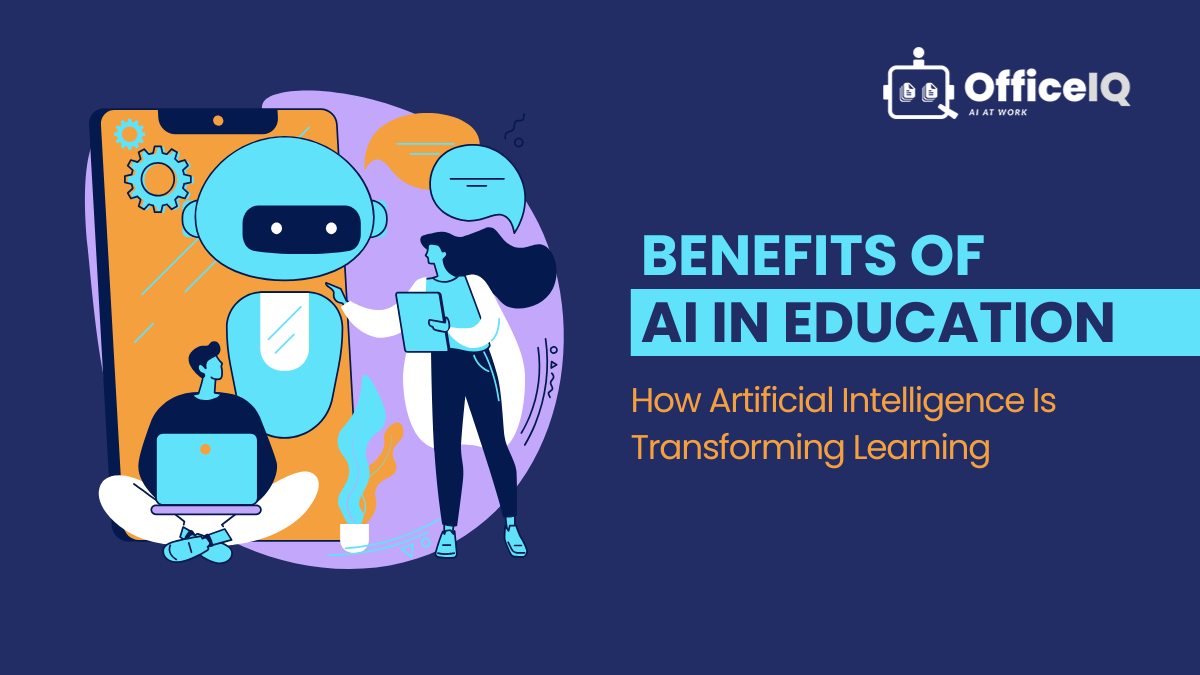Artificial Intelligence (AI) is no longer just a buzzword—it is actively shaping the way education is delivered and consumed. Schools, colleges, and online platforms are now embracing AI to create smarter, more adaptive, and efficient learning environments. The impact is so significant that conversations around benefits of ai in education are at the center of educational innovation today.
In this blog, we’ll explore how integrating AI solutions in education benefits both students and teachers. From personalized learning AI to AI-powered teaching assistants, the transformation is real, and it is only getting stronger.
Top Benefits of AI in Education for Students and Teachers
- Personalized Learning AI: Tailoring Education to Every Student
One of the most impactful AI education benefits is personalized learning. Traditionally, classrooms have been designed for group learning, which often overlooks the needs of individual students. AI changes this completely by analyzing each student’s learning style, pace, and performance to deliver customized study plans.
For example, if a student struggles with math but excels in reading, AI tools can provide extra exercises and interactive lessons in math while allowing them to move faster in reading. This adaptive model ensures students don’t feel left out or held back.
Why it matters:
- Students learn at their own speed.
- Weak areas are strengthened through targeted practice.
- Advanced learners are not slowed down by the class average.
This kind of personalized learning AI makes education more engaging, motivating, and effective.
- AI for Students: Smarter Study and Exam Preparation
Another major AI education benefit is the availability of intelligent study tools. Today’s students have access to AI-powered apps that can:
- Summarize large chapters into key notes.
- Provide instant answers to queries.
- Offer practice tests that adapt to their performance.
For instance, platforms like AI tutors or chatbots can act as “always available” guides for students, answering doubts in real time. This reduces dependency on teachers outside classroom hours and gives students more control over their own learning.
Additionally, AI for students can improve exam preparation by identifying weak areas and suggesting revision strategies. Imagine a digital coach that knows exactly what you need to study before your test—it’s like having a personalized tutor 24/7.
- AI Helping Teachers: Reducing Workload and Enhancing Teaching
While students benefit from smarter tools, AI also plays a big role in supporting teachers. One of the biggest challenges teachers face is managing administrative tasks like grading, attendance, and preparing reports. These repetitive jobs take up valuable time that could otherwise be spent on teaching.
AI helps teachers by automating these tasks, allowing them to focus more on interactive lessons and building connections with students. For example, AI grading systems can quickly check multiple-choice tests or even assess short essays.
Key benefits of AI helping teachers:
- Saves time by automating routine tasks.
- Provides detailed performance analytics for each student.
- Assists in lesson planning by recommending resources.
This means teachers can spend more time nurturing creativity, critical thinking, and problem-solving skills in their students.
- Breaking Barriers with Accessibility
Education should be inclusive, and AI is playing a major role in breaking barriers. Students with disabilities or learning challenges benefit significantly from AI-powered tools. For instance, speech-to-text applications help students with hearing impairments, while text-to-speech tools assist those with reading difficulties.
By creating a level playing field, AI ensures that every student, regardless of background or ability, has access to quality education.
- Global Learning Opportunities
Another powerful AI education benefit is access to global knowledge. AI enables students to connect with resources, teachers, and peers worldwide. With AI-powered translation tools, language barriers are minimized, allowing students to access study materials in different languages.
This global approach broadens perspectives, prepares students for international opportunities, and makes education more inclusive and interconnected.
- Real-Time Feedback and Improved Outcomes
AI provides immediate feedback, something traditional classrooms often lack. Instead of waiting for exam results, students can instantly know where they went wrong and how to improve. Teachers, too, get real-time insights into student progress, allowing them to adjust their teaching methods accordingly.
This ongoing cycle of learning and feedback results in better student outcomes and higher levels of engagement.
- Preparing Students for the Future
AI is not just changing how students learn; it is preparing them for the world of tomorrow. With industries rapidly adopting AI, students familiar with AI-driven systems gain a competitive edge. Understanding and using AI tools equips them with critical digital skills that will be in demand across all career paths.
Conclusion
The integration of AI in education is transforming classrooms, making them smarter, more efficient, and more inclusive. The AI education benefits are clear: students enjoy personalized learning AI, smarter study tools, and better outcomes, while teachers benefit from automation, analytics, and improved focus on teaching.
As technology continues to advance, the role of AI for students and AI helping teachers will only grow stronger. The future of education is not just digital—it’s intelligent, adaptive, and deeply personalized.
AI is not here to replace teachers but to empower both students and educators, ensuring a brighter, more innovative future for learning.
FAQs
Q1. What are the main benefits of AI in education?
AI in education improves personalized learning, helps students with smart study tools, supports teachers by reducing workload, and ensures real-time feedback for better outcomes.
Q2. How is AI helping teachers in classrooms?
AI helps teachers by automating grading, attendance, and lesson planning. It saves time and allows them to focus more on interactive teaching and student engagement.
Q3. What are the benefits of AI for students?
Students benefit from AI through adaptive study plans, instant answers to doubts, personalized learning AI platforms, and smart exam preparation tools.

Leave a Reply